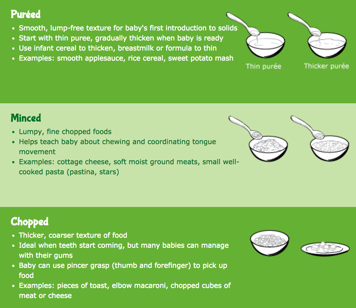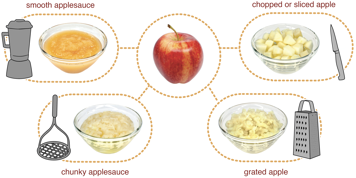It is exciting to watch your baby eating solid foods and showing an interest in your food. Here are some ways to fit your baby's feedings in with the whole family.
Moving from one texture to another
From six to 12 months of age, your baby will become better able to eat new foods, try new textures and feed themselves. Transitioning (moving) from one texture to the next is important to teach your baby about chewing. Since every baby develops at their own pace, be patient with their progress, but continue to offer new textures.
There are three common textures for solid baby food:

Changing food textures for your baby
Depending on what you are cooking, you can alter food textures using simple kitchen tools such as a potato masher, blender or food processor
Use your kitchen's blender for even blending of meat and vegetables and a potato masher for softer foods such as potato, squash and apple. You can purée, mince or chop food using the different blender settings or by adjusting the amount of time for blending. You can also add milk or formula to the food when blending to thin the consistency.
It's easy to alter food textures to suit your baby's chewing ability using tools you may already have in your kitchen.

Clockwise from top-left:
- smooth apple sauce
- chopped or sliced apple
- grated apple
- chunky apple sauce
Think, for example, of a dinner meal of chicken breast with potato and broccoli for the family. You can easily purée, mince or chop the chicken, potato and broccoli to a texture that is appropriate for your baby's chewing ability. You cook once but simply alter the food for your baby's level of texture. Remember that you may have to offer the food a few times on the plate on different days before your baby is ready to try it.
Cook your baby's food without adding salt or sugar. You can either add salt, sugar or strong spices to the meal after you have served a portion to your baby or you can cut out the salt and sugar for everyone.
Breast milk and formula
Babies still require regular breast milk or formula feeds when eating solid foods. The amount may vary depending on their intake of food. Offer your child solid foods before offering breast milk or formula. They are more likely to try new solid foods when they are very hungry.
Water and juice
Babies who are less than six months old do not need water. They actually need all the nutrients, fats and calories from breast milk or formula. From six to 12 months, water is acceptable if it is a very hot day, but otherwise it would still be best to offer breast milk, formula or 3.25% milk instead.
Juice contains a lot of sugar; avoid giving it to babies and young children.